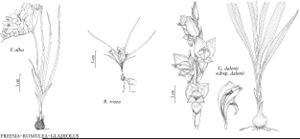Difference between revisions of "Romulea rosea"
Topogr. Verz. Pflanzensamml. Ecklon, 19. 1827.
FNA>Volume Importer |
imported>Volume Importer |
||
| (3 intermediate revisions by 2 users not shown) | |||
| Line 6: | Line 6: | ||
|place=19. 1827 | |place=19. 1827 | ||
|year=1827 | |year=1827 | ||
| + | }} | ||
| + | |special_status={{Treatment/ID/Special_status | ||
| + | |code=I | ||
| + | |label=Introduced | ||
| + | }}{{Treatment/ID/Special_status | ||
| + | |code=F | ||
| + | |label=Illustrated | ||
}} | }} | ||
|basionyms={{Treatment/ID/Basionym | |basionyms={{Treatment/ID/Basionym | ||
|name=Ixia rosea | |name=Ixia rosea | ||
|authority=Linnaeus | |authority=Linnaeus | ||
| + | |rank=species | ||
|publication_title=Syst. Nat. ed. | |publication_title=Syst. Nat. ed. | ||
|publication_place=12, 2: 75. 1767 | |publication_place=12, 2: 75. 1767 | ||
| Line 28: | Line 36: | ||
|elevation=0–50 m | |elevation=0–50 m | ||
|distribution=Calif.;South Africa. | |distribution=Calif.;South Africa. | ||
| − | |discussion=<p>M. P. de Vos (1972) recognized five varieties of <i>Romulea rosea</i>; the plants naturalized in North America correspond to < | + | |introduced=true |
| + | |discussion=<p>M. P. de Vos (1972) recognized five varieties of <i>Romulea rosea</i>; the plants naturalized in North America correspond to <i></i>var.<i> australis</i> (Ewart) M. P. de Vos, which has become a common weed of lawns, pathways, and roadsides in Australia, where it is a pest. To date, weediness does not seem to be the case in the parts of California where the species occurs.</p> | ||
|tables= | |tables= | ||
|references= | |references= | ||
| Line 37: | Line 46: | ||
-->{{#Taxon: | -->{{#Taxon: | ||
name=Romulea rosea | name=Romulea rosea | ||
| − | |||
|authority=(Linnaeus) Ecklon | |authority=(Linnaeus) Ecklon | ||
|rank=species | |rank=species | ||
| Line 52: | Line 60: | ||
|publication title=Topogr. Verz. Pflanzensamml. Ecklon, | |publication title=Topogr. Verz. Pflanzensamml. Ecklon, | ||
|publication year=1827 | |publication year=1827 | ||
| − | |special status= | + | |special status=Introduced;Illustrated |
| − | |source xml=https:// | + | |source xml=https://bitbucket.org/aafc-mbb/fna-data-curation/src/2e0870ddd59836b60bcf96646a41e87ea5a5943a/coarse_grained_fna_xml/V26/V26_837.xml |
|genus=Romulea | |genus=Romulea | ||
|species=Romulea rosea | |species=Romulea rosea | ||
Latest revision as of 21:17, 5 November 2020
Plants 3–12(–30) cm. Corm tunicate, 5–15 mm diam.; tunic hard, woody, splitting above and below into acuminate segments, those below bent backward. Stems usually branched below ground level; branches (peduncles) aerial, suberect, becoming falcate, ultimately erect. Leaves (2–)6–9, much exceeding stem; blade 10–30 cm × ca. 1.5 mm. Spathes green or flushed with purple; outer 12–25 mm, margin narrow, membranous; inner margin brown-streaked, broad, membranous. Tepals pink to purple, usually pale yellow in cup, outer pale abaxially, main veins dark green to purple, lanceolate, 13–22 × 3–4 mm; perianth tube 2–3.5 mm; filaments ca. 5 mm; anthers ca. 4 mm; style branching opposite upper 1/3 anthers; branches ca. 2 mm, shorter than anther apices. Capsules 10–15 mm. Seeds ca. 2 mm diam.
Phenology: Flowering mainly Mar–Apr.
Habitat: Abandoned dwellings, along paths, in meadows
Elevation: 0–50 m
Distribution
Introduced; Calif., South Africa.
Discussion
M. P. de Vos (1972) recognized five varieties of Romulea rosea; the plants naturalized in North America correspond to var. australis (Ewart) M. P. de Vos, which has become a common weed of lawns, pathways, and roadsides in Australia, where it is a pest. To date, weediness does not seem to be the case in the parts of California where the species occurs.
Selected References
None.
